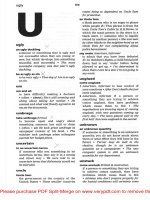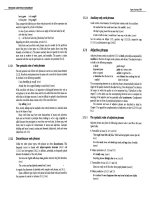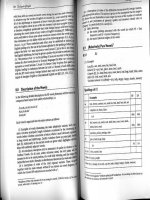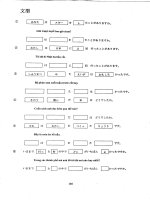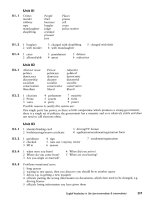Sound Patterns of Spoken English phần 10 pdf
Bạn đang xem bản rút gọn của tài liệu. Xem và tải ngay bản đầy đủ của tài liệu tại đây (78.32 KB, 15 trang )
142 Index
Index
abbreviations, weak forms 46–8
abstract phonology, and vocal
tract 6, 60–1
accents,
ability to imitate 69–70
English 19–20
variation across and within
62–3
Ackermann, H. 75
acoustic displays 76
acoustic input, matching of lexical
representation to 67–71
acquisition, suppression in 52–3,
71
algorithms,
access by 94–5, 108
language-specific 94–5
‘allegro’ 113, 117
alphabet, knowledge and phoneme
awareness 69
alphabetic writing system 11–12
alternations, motivated 6
Altmann, G. T. M. 96
alveolar assimilation 18–19, 23,
77
alveolar consonants, citation-form
and casual 78–9 (figure 4.1)
alveolar fricatives (final),
assimilation to following
postalveolars 19
American English 15, 24, 29,
35, 37, 38, 39, 42, 56, 84–5,
88
see also General American
English
Anderson, A. H. 78
Anderson, J. M. 66
Anderson, S. 6
Anttila, A. 62
applications 111–26
Archambault, D. 111
Archangeli, D. 64
articulation,
and brain 12, 58–9
constraints on 12
see also ease of articulation;
manner of articulation
articulatory choices, of native
speakers 10
articulatory phonology 58–9
Index 143
aspiration, in unstressed syllables
26
assimilation 17, 18–19, 84
across word boundaries 123
Beckman’s theory of laryngeal
80–1
modelling 77
attention 7, 77
augmented transcription 73–4
Australian English 20, 29, 30
South East 87
autosegmental phonology 6,
56–8, 59
tiers in 66–7
Bailey, C J. 53, 115, 116
Al-Bamerni, A. 8
Bard, E. G. 96, 103
Barry, M. 76
Barry, W. J. 35, 86–8
base forms 7
Bates, S. 22
Bauer, L. 35
Beckman, M. E. 80, 83, 112
beginnings of words,
processes affecting 42–5
word recognition and 92–3,
102
Bengali 94, 95
Bladon, R. A. W. 8
Boardman, I. 126
Boersma, P. 63
Bolozky, S. 51
Bond, Z. S. 25, 82, 118, 123
Borowski, T. 87
borrowing 115–17
brain, and articulation 12,
58–9
Brazilian Portuguese 112
Breton 113
Browman, C. 22, 26, 58–9, 91
Brown, G. 1, 17, 28, 35, 73, 74,
78, 103, 122, 124
Listening to Spoken English
119
Bryan, W. L. 105
Bybee, J. 70
Cambridge 76–80
Canadian French 111
careful speech, CVCV alternation
34
carefulness, continuum 90–1
caretaker speech to infants
117–18
casual speech,
experimental studies in
72–110
interpretation of: experiments
96–104
perception of 89–109
processes 11–13, see also ‘fast
speech’ rules
production 72–88
in speech synthesis 125
see also ‘allegro’
casual speech reduction 126
factors influencing
14–15 (table 2.1)
Catalan 8
categories, abstract 6–7
Cedergren, H. J. 53
Central Ohio 19
child language 111
child language acquisition,
learning of normalization 89
of phonology 63
Trace/Event Theory 67–71
Chomsky, Noam 6
citation form,
mapped directly to surface form
60–1
144 Index
citation form (cont’d)
mapped to place-assimilated
forms 108
phonological differences from
1–3, 13
students taught only 73
transparency of spoken version
70–1
in written languages 114
closure, reduction for obstruents
27–9, 34
cluster simplification 36–42, 66
co-phonologies 62
coarticulation 8, 59, 72
differences across languages 91
formant frequencies at CV
boundary 74–5
limits on degree of 10
resistance to 8
vowel-to-vowel 126
Cobb, H. 74, 76
Cockney 30, 37, 44, 63
codas 33–4, 58
cognitive factors 11–12, 68–71
Cohn, A. 41
Cole, R. 91
Coleman, J. S. 61, 125
collective unconscious 116–17
communication, demands of the
moment 12–13
compute or store problem 94
computers, interacting with 103,
124–6
Comrie, B. 92
connected speech,
distinct patterns of reduction
12
learning foreign 119–24
perception by native speakers
120–4
phonetic reduction in 3
phonological reductions 3–4
processing lag in perception
122–4
studies of processes 76–80
transcription of 10–11
connectionism see Parallel
Distributed Processing (PDP)
Connine, C. 85
consonant clusters (final), more
likely to drop second than
first element 66
consonants (final),
deletion of 33
devoicing 111–12
constraints,
ranking 63
universal 61–4
constraints approach to phonology
5–6, 9, 12, 13, 61–4
context 89, 105, 106, 115
convention, and history 7, 13
conversational English, processes
in 13, 14–48
conversational phonology,
in 1990s 56–67
as dynamic and distributed 14
new millennium 67–71
past work on 49–52
conversational speech, teaching
perception of 123
Cooper, A. M. 18
Coventry 20, 30
Crain, S. 68
Cruttenden, A. 19, 34, 47, 48
CSPs see connected speech, studies
of processes
Cutler, A. 91, 92, 94, 102, 104
CV boundary, formant frequencies
at 74–5
CV pattern (closed-open) 33, 56
association lines 56–8
Index 145
CVCV alternation 34–6
Czech 75
Ú-assimilation 17, 84
Ú-reduction 43–4
Dahan, D. 104
Dalby, J. M. 33, 73
Daneman, M. 105
Danish 115
databases, use of labelled 109
Davis, M. 104
de Jong, K. 29, 86
Decamp, D. 116
degemination 43
deletions, in fast speech 11, 58,
71
denasalization 8
Dependency Phonology 66–7
descriptive adequacy 6
devoicing 30–2, 61
final consonant 111–12
vowels 80–1, 112
word-final 7
Dilley, L. 18
directionality,
of phonological change 115
in rule order 54–6
Dirksen, A. 61
discourse 13, 15, 16–17
Docherty, G. 68, 78
Donegan, P. 56, 116
Dressler, W. U. 51, 53, 56, 113,
114, 117, 120
drift 117
Durham 63–4
Dutch 111
ease of articulation 3, 7
Edinburgh 20, 37
electropalatography (EPG) 18,
28, 75–80, 86
Elliot, D. 116
Elman, J. L. 107–8
endoscopy, fibreoptic 37
English,
devoicing of oral obstruents 7
heavy syllables in 32
lenition in 113
Midlands accents 30, 63
phonology element of 111–13
phrase- and sentence-final
lengthening 16
reduction processes in 19–20
South East 87
standard forms 114–15
as a stress-timed language
20–2
suprasegmental properties 26
tapping in 29
as a topic-comment language
16
varieties of 19–20
vowel reduction 76
West Midlands 87
see also American English;
Australian English; Cockney;
New Zealand English
environment, phonetic/
phonological 4–5, 18–19,
108
EPG see electropalatography
(EPG)
Estonian 113
Ewen, C. J. 66
experimental studies, in casual
speech 72–110
explanatory adequacy 6, 71
Fabricius, A. H. 39
faithfulness 63–4
Farnetani, E. 4, 10, 28, 78
Fasold, R. 53, 115
146 Index
‘fast speech’ rules 11–13, 17,
51–2, 120
see also casual speech processes
feature bundles 108
features 6
Finno-Ugric languages 113
Firbas, J. 16
first language acquisition,
applications 117–18
Firth, J. R., prosodics 60–1
Firthian prosodics 60–1, 66
flapping see tapping
FLMP see Fuzzy Logical Model of
Perception (FLMP)
focus 15, 16
Fokes, J. 25, 82
Foley, J. 5
foreign language, understanding a
119–24
formal/citation form speech see
‘lento’
formality 17
Fosler-Lussier, E. 15
fossils 6, 7
Fougeron, C. 18
Foulkes, P. 68
Fowler, A. 68, 69
Fowler, C. A. 3, 16, 91
Fox, R. 29, 85
Fraser, H. 78, 105
Frauenfelder, U. 93, 94
Frazier, L. 93
free ranking 62
French 8, 33, 42, 78, 112, 117
frequency 14–15, 61, 126
fricatives,
reduction in 18
schwa absorption 24–5
Fudge, E. 5, 32
function, and phonological
reduction 16
functional load, of codas
compared with onsets 33
functional phonology, and
perception 9
Fuzzy Logical Model of Perception
(FLMP) 106
Gaies, S. 123
Gaskell, M. G. 19, 94, 95, 97,
102, 107–8, 123
gated utterances 120–4
listeners’ transcriptions of
100–1 (table 4.1)
gating 95
gating experiments, late
recognition 95–104
General American English 20,
29, 67
generative grammar 6
Generative Phonology 49–50
optional rule 50–2, 62–3
German 7, 26, 59, 67, 75, 111
Gestalt pattern perception 104,
106
gestural model, Fowler’s 91
Gestural Phonology 6, 58–9, 61,
70, 71, 83
gestures 58–9, 91
diminished rather than deleted
83
prosodies as 60–1
glottal reinforcement 36–40, 66
glottal stopping, Optimality
Theory 63–4
glottalling 39, 64–5, 66, 77
Goldringer, S. D. 67
Goldsmith, J. 56–8
Goldstein, L. 22, 26, 58–9, 91
Gothic 113
gradation, in Finno-Ugric
languages 113
Index 147
Greek 31, 122
Greenberg, J. 80
Greenberg, S. 15, 125–6
Grosjean, F. 95–6
Grossberg, S. 126
Guy, G. 62
H&H theory 12, 74–5, 90–1
h-dropping 44
habit 13
Hall, R. Jr. 117
Hammond, M. 64
Hardcastle, W. J. 28, 35, 76,
86–8
Hare, M. 107–8
harmony 66
see also assimilation
Harris, J. H. 51
Harter, N. 105
Hawaiian 115–16
Hawkins, S. 106, 126
Hertrich, I. 75
Herzog, M. 114
heterogeneity, ‘orderly’ 114
Hirschberg, J. 125
historical phonology 113–17
history, and convention 7
Holmes, J. 37, 38, 85
Holst, T. 77
homophones, and interpretation of
reductions 83
Hong Kong Cantonese 121
Hooper, J. B. 50, 53, 54–6
Horvath, B. 87
Housum, J. 3, 16
Howes, D. 15
hyper-articulation, and hypo-
articulation see H&H Theory
icons 46
implicational laws 115–16
impressionistic production studies
72–3, 109
indexical information 67
in traces 69–71, 107–9
inertia see vocal tract inertia
infants, caretaker speech 117–18
information theory 33
input,
articulatory properties 5–6, 9
mapping into output 107–9
to young children 118
intelligibility 9
situationally-determined 12
International Association for
World Englishes 19
interpretation, of casual speech:
experiments 96–104
intonation 6, 104
Inuktitut 93
IPA chart 76
Irish 27, 29, 30
Italian 78, 112, 117
Jaeger, J. 80
Jakimik, J. 91
Jannedy, S. 112
Japanese 8, 83, 112
Jassem, W. 112
Johnson, G. 62
Johnson, K. 67
Jones, C. 66
Jun, S A. 112
Jusczyk, P. 67, 89
Kager, R. 62, 63
Kaisse, E. M. 6
Keating, P. 4, 10, 18
Kelly, J. 5, 60
Kerswill, P. 35, 63–4, 76, 78
kinematics, oral 86
Kisseberth, C. 22, 33
148 Index
Klatt, D. 89
Kohler, K. 26, 59
Korean 112
Koster, C. J. 119, 120, 120–4
Krull, D. 74–5
l-vocalization 35–6, 77, 86–8,
112
laboratory speech, use of 77–80,
88
Labov, William 19, 53–4, 114,
115
Laferriere, M. 84–6
Lahiri, A. 18, 93, 94, 94–5
Langendoen, D. T. 61
language families, changes across
116–17
language games 69
language-specific algorithms
94–5
language-specific reductions 3–4,
13
languages, syllable structures
32
laryngeal assimilation 80–1
Lass, R. 61
late recognition, gating
experiments 95–6
laterals, schwa absorption 22–3
Latin 112, 114, 117
laxing 116
Lea, W. 126
Legum, S. 116
Lehiste, I. 29, 93, 104
lenition 27, 28–9, 66, 112–13,
114
double 32
‘lento’ 113, 114, 117
letter-to-sound rules, in reading
69
lexeme-specific phonology 2
lexical access,
by algorithm 94–5
phonological representation in
94
lexical access model 93
lexical diffusion 2
lexical item, language-independent
generation of all possible
pronunciations 61–4
lexical representation, matching to
acoustic input 67–71
lexicography 3
lexicon,
phonemic inventory and
morphology derived from the
70–1, 82
phonemic system as a product
of the 69–71
recognition and phonological
different 67–71
Liberman, M. 58
Lieberman, P. 3, 16
Lindblom, B. 12, 74–5, 76,
90–1
linguistic unit, membership and
function in a larger 15, 18
liquids (syllabic ‘r’ and ‘w’), schwa
absorption 23–4
listening,
skills in foreign language
learning 119–24
tuning in 89–90
Lively, S. 123–4
Lloyd, P. 85
loan phonology 117
Local, J. K. 5, 60, 61, 67
locus 74–5
Lodge, K. R. 18, 20, 25, 37, 43,
59–60, 73
research sites 20: map
21 (figure 2.1)
Index 149
synthesis of phonological
explanations 64–7
Lovins, J. B. 83, 88
Luce, P. A. 96
Lundberg, L. 68
McClelland, J. J. 107–8
MacNeilage, P. 90–1
Malecot, A. 85
Maneva, B. 111
Mann, V. A. 68, 69
manner of articulation, stricture-
based definitions 80
Manuel, S. 10, 43, 75, 82–3, 83,
84
Map Task 78
marked forms 115
markedness 116
Marslen-Wilson, W. D. 18, 19,
91–2, 94–5, 97, 102, 107–8,
123
Massaro, D. W., and FLMP 106
meaning,
and sound, united in the mental
lexicon 91–3
and sounds 1, 4, 68–71
words accessible through 105
medium 15, 17
Mehler, J. 94
mental lexicon 70–1, 89
access using traces 107–9
where sound and meaning are
united 91–3
Merikle, P. M. 105
Merrit, D. L. 47
metalinguistic abilities 68–71
metrical phonology 58
Mexico City Spanish 51
Miller, D. 82
mind/body problem 6–9
monophthongization 27
morphological class, in reduction
15, 19
morphology,
derived from the lexicon 70
‘frozen’ 47
mother–child interaction,
phonological reductions in
118
Mullennix, J. W. 67, 90
Myers, C. W. 126
nasal deletion 88, 112
nasal incorporation 66
nasal relocation 40–2, 61
nasalization, of vowels 7–8, 49
nasals,
assimilation 18
dentality through 84
English coronal 95
schwa absorption 23
Nathan, G. 62, 63
native speakers,
articulatory choices 10
desire to sound like 9
habits used subconsciously 8,
70, 74, 93–4
learning to listen like 119–24
perception of connected speech,
experiments 120–4
pronunciation/perception targets
and processes 10
systematic behaviour of 11, 13
natural classes 6
natural language, variation in
pronunciation 114–16
natural phonology 52–3
naturalness 115, 125
Nespor, M. 58
New Zealand English 20, 35, 38
Wellington Corpus of Spoken
85
150 Index
newscasters’ speech 73
Nix, A. 19, 95
Nolan, F. 47, 74, 76, 77, 78
non-binary output, in
phonological theory 77
normalization 67, 89
Norris, D. 91, 94
Norwich 20, 37
obstruents,
devoicing of English oral 7
no voicing in final 61
reduction of closure for
27–9
syllabic 24–5
voiceless as the unmarked case
31
Obusek, C. J. 104
‘of’, as a weak and strong form
34–5
Ogden, R. 24, 60, 61
Ohala, J. J. 80
Olofsson, A. 68
onsets 33–4, 58
Unstressed Onset Faithfulness
63–4
Optimality Theory (OT) 58,
61–4
glottal stopping 63–4
phonological grid
64–5 (figure 3.1)
variation 62–3
optional rules 50–2, 62–3, 71
Ostendorf, M. 18
OT see Optimality Theory (OT)
output,
mapping input into 107–9
non-binary 77
perceptual properties 5–6, 9
tailored to situation 12
overlap, gestural 22, 58, 71
palatalization 66, 77, 112
use of term 44–5
palatographic studies 75–80
Map Task 78
Paradis, C. 18, 59
Parallel Distributed Processing
(PDP) 107–9
parsimony principle 6
Patterson, D. 85
PDP see Parallel Distributed
Processing (PDP)
Peasmarsh 20, 44
perception,
of casual speech 13, 89–109
and functional phonology 9
holistic 104, 105, 106, 110
see also speech perception
perception studies, particular
processes 80–8
perceptual framework 89–90
Perkell, J. 89
philosophy, phenomenological
105
phoneme awareness, development
of 68–71
phonemes, abstractions in mental
lexicon 70
phonemic restoration 104–5
phonemic system, as a product of
the lexicon 69–71
phonetic processes, with
phonological consequences
8
phonetic reduction 3
phonetic transcription 10–11,
72–4
choice of symbols guided by
phonology 10
impressionistic 72–3, 87
phonetic/phonological
environment 15, 18–19
Index 151
phonetic/phonological forms, in
traces 70
phonetics 4
distinguishing from phonology
8–9
influence of phonology on
10–11
or phonology 3–11
‘phonological conspiracy’ 33
phonological explanation 49–71,
116
phonological processes, ranking
61–4
phonological reductions see
reduction
phonological representation, in
lexical access 94
phonological rules 5, 50
and rate 50–1
and style 51
phonological theory, non-binary
output in 77
phonological variability,
input to second language
acquisition 123–4
sources of 14–15 (table 2.1)
phonology,
active 97, 105, 110
applications 111–17
constraints-based approach to
5–6, 9, 12, 13, 61–4
directionality of change 115
distinguishing from phonetics
8–9
influence on phonetics 10–11
meanings of 4–6, 10
or phonetics 3–11
in speech perception 93–104
phonotaxis, violation of 83
phrases, used repeatedly, reduction
in 46
Pickett, J. M. 16, 90
Pierrehumbert, J. 54, 59
Pisoni, D. B. 123–4
Polish 112
Pollack, I. 16, 90
Polysp model of speech perception
106
polysystematicity 66–7
Port, R. F. 104
Portuguese 8, 42, 112
pragmatic features 13
predictions 115–16
prescription 15, 16
Price, P. J. 81
Prince, A. 62
probabilities 63–4
production, of casual speech
72–88
production studies,
general 72–80
impressionistic 72–3
particular processes 80–8
promotion 2
pronunciation 1–13
in Generative Phonology 50
language-independent generation
of every possible 61–4
normal native speaker 126
percolation up to become
standard 117
pronunciation/perception targets
and processes of native
speakers 10
Prosodic Phonology, Firthian
60–1, 66–7, 70, 71, 83
Prunet, J F. 18, 59
psycholinguistic model, of
perception of words 91–3,
104
psycholinguistic theories, of speech
perception 9, 104–10
152 Index
qualitative models 91
quantitative models 91
r, syllabic 24
railroad telegraphers 105
ranking,
constraint 63
of phonological processes
61–4
preferred versus unpreferred
62–3
see also free ranking
rate 11–13, 15, 17, 72, 77, 89
and phonological rules 50–1
and style see strates
reading aloud 105
reading skills, acquisition of
68–9, 70
Recasens, D. 4, 10
recognition lexicon, and
phonological lexicon 67–71
reduced forms, become standard
2
reduction 2–4
distinct patterns in connected
speech 12
factors influencing casual speech
15 (table 2.1)
interpretation of 83
language-specific 3–4, 13
in mother–child interaction
118
perceptual consequences of 13
processes in English 19–48
rate of speech and 11–13, 17
in scripted speech (read or
memorized) 73–4
reference groups 17
register 10
relaxation, physical mapped to
phonological 52–3
repetition 123
resonants, syllabic 22
rhetoricians 3
rhythm 58, 81
Roach, P. 82
Roca, I. 62
Rodgers, J. 26, 80–1
Rohl, M. 68
Romance languages 31, 112, 114
rule order 54–6
rule suppression, in acquisition
52–3
Russian 92
Sankoff, D. 53
Sapir, E. 117
Sato, C. 123
Saussure, Ferdinand de 5
Schultze, W. 117
schwa absorption 22–7
fricatives 24–5
laterals 22–3
liquids (syllabic ‘r’ and ‘w’)
23–4
nasals 23
in OT study 64
voiceless vowels 25–6
schwa devoicing 25
schwa incorporation 61, 81–3
schwa suppression 26–7
Scots English 23, 30
scripted speech (read or
memorized) 17, 73–4,
78–81
second language acquisition,
applications 119–24
experiments 120–4
variability of input 123–4
segmental categories 6
Segui, J. 94
Semon, R. 67
Index 153
Sergeant, P. 82
Shanghai Chinese 112
Shankweiler, D. 68
Shattuck-Hufnagel, S. 18
Shepherd’s Bush 20
Sherman, G. L. 105
Shillcock, R. C. 96, 103
Shockey, L. 16, 17, 28, 32, 43,
51–2, 73–4, 77, 78, 84, 87,
118, 120–4
simplicity 115
simplification,
in child language acquisition
123
of ‘st’ 113
Simpson, A. 60
Skoyles, J. R. 110
Slavic languages 7, 111
slow speech 13
Smith, C. 117
Smith, R. 106, 126
Smolensky, P. 62
sociolect 17
sociolinguistics 3, 73, 83
sonority,
duration or amplitude 81
in word-initial and word-final
clusters 33
Sotillo, C. F. 3–4, 94
sound,
and meaning, united in the
mental lexicon 91–3
type of, and place of occurrence
12
sound changes,
directionality of 115
prediction of 115–16
sounds, and meaning 1, 4, 68–71
Spanish 8, 112, 113, 117
spectrography 73–4, 74–5, 83,
88
speech see laboratory speech;
scripted speech; spontaneous
speech
speech perception 89–109
directness of 91
Gestalt pattern perception 104,
106
modelling 90–1
phonology in 93–104
psycholinguistic theories
104–10
‘Reading’ paradigm theories
110
‘Soup’ paradigm theories 110
theories of 67
the word 91–3
speech predisposition 117
speech production 72–88
speech recognition 125–6
computer 3, 103, 109: chart
parsing or lattice technique
103
syllable-based 126
traces in 107
speech synthesis 61, 81, 83,
125
speech technology 124–6
spelling pronunciations 69
spelling skills 70
spelling systems,
and phonetic transcription 10
and word recognition 100–2
Spelman Miller, K. 16
Spensley, F. 103
spoken language, and written
language 90
spontaneous speech,
citation form compared with
17
CVCV alternation 34–6
spreading 60
154 Index
Stampe, D. 8, 48, 52–3, 54–6,
61, 69, 115
standard,
percolation up in language
families 117
reduced forms become 2
and variation 114–16
Standard Average European
languages, word recognition
in 92
Standard Southern British 20,
24, 27, 30, 34, 35, 38, 39,
44, 63–4, 81, 87, 98–100
Stockport 20, 44
storage, skilled 105
strates 51–2
stress,
as a conditioning factor 18,
20–32, 34, 58
perception of 106
placement 48
stress patterns 13
style 10, 17, 77
and co-phonologies 62
hierarchy 54
and phonological rules 51
and rate see strates
target and variation 123
substratum languages, influence on
superstratum languages 117
superstratum languages, influence
of substratum languages on
117
suppression, in acquisition 52–3,
71
suprasegmental features 26, 83,
104, 126
surface phonetic output see
pronunciation
Sussman, H. M. 74
Swedish 8, 75, 112
Swerts, M. 125
switchboard corpus 85
syllabic conditioning factors 22,
32–42
syllable production 72
syllable shape 13, 32–3, 42
syllable structures,
influence on perceptual cues
83
of selected languages 32
and syllable boundaries 58
syllable-final adjustments 36–42,
59–60
syntactic function, in reduction
18
t-glottalling 39, 66, 77
in several accents
64–5 (figure 3.1)
t/d (final), alteration of 19,
36–40
Al-Tamimi, Y. 44, 70
tapping 29–30, 34, 61
OT study of 64
studies of 84–6
tensing 116
Terbeek, D. 29, 85
Thompson, H. 103
Thompson, S. A. 116
tiers, in autosegmental phonology
66–7
timing 59, 60–1, 72, 88, 104
tone 6
tone languages 56
TRACE 108
Trace/Event Theory 54, 67–71,
94
traces,
access to mental lexicon 107–9
acoustic units as 67–71
lack of molar contact 78
Index 155
othographic and auditory
68–71
phonetic/phonological forms in
70–1
transillumination 82–3
Trubetzkoy, N. I. 75
Truin, P. G. M. 122
tuning in 89–90
Tunmer, W. E. 68
Turk, A. 27, 85
Turkish 7, 111, 112
turning point 74–5
typing 105
typological adjustment 115–16
underarticulation 13, 75
underspecification 59–60, 66,
94–5, 108
universals 5–6
unmarkedness 115
unscripted speech see spontaneous
speech
Unstressed Onset Faithfulness
63–4
v, word-final 35
Vaissière, J. 18, 116
van Donselaar, W. 104
variable rules 53–4, 71
variables, sociolinguistic 10
variation,
accounting for conditioned 49
across accents and within
62–3
dynamic features leading to
10
‘free’ 62–3
in Optimality Theory 62–3
over time and across accents
53–4
predictability 49, 50
present within lexical items
107–9
and standards 114–16
Variationists 53–4
Vaux, B. 29
Vennemann, T. 115–16
vernacular forms, percolation up
to become standard 117
Verner’s Law 32
VNC 40–2
vocal tract 8, 9
and abstract phonology 6,
60–1
constraints on 72, 91
settings represented as traces
69–71
vocal tract inertia 3, 11, 55–6,
71
Vogel, I. 58
voice quality 6
voiced alveolar stops, assimilation
18
voiceless stops, assimilation
18–19, 28
voiceless vowels, schwa absorption
25–6
voicing, and devoicing 30–2
voicing through 32, 34
vowel centralization 48
vowel devoicing 22, 80–1, 112
vowel harmony 66
vowel nasalization 7–8, 49, 112
vowel reduction, in English 76
vowels, tensing and laxing of
116
Vulnerability Hierarchy 14–19
w, syllabic 24
Waibel, A. 126
Wall, S. 68
Wang, W. 2
156 Index
Warner, N. 83
Warren, Richard 104–5
Watkins, A. 96
weak forms 46–8
weakening see lenition
Weil, S. 70
Weinreich, U. 114, 115
Wells, J. C. 22, 27, 33, 36, 38,
40
Accents of English 19–20, 109
Welsh 112–13
Welsh, A. 91
Whalen, D. H. 10, 75
Whorf, B. L. 92
Wichmann, A. 16
word lists 87–8, 90
word perception, theories of
91–4
word recognition 102–4
frequency and 92
global judgements 97–8
‘isolation point’ 92
late in gating experiments
95–6
psycholinguistic model of
speech perception 91–3
Shockey’s experiments
96–104
and spelling systems 100–2
word-final clusters, and reduction
18
words,
accessible through meaning
alone 105
information status of 3
see also beginnings of words
working memory, processing and
storage 105
world Englishes 19–20
Wright, S. 35, 76, 77
written language 113–14
and spoken language 90
X-ray microbeam data 86
Zee, E. 112
Zue, V. W. 29, 84–6
Zwicky, A. 51
